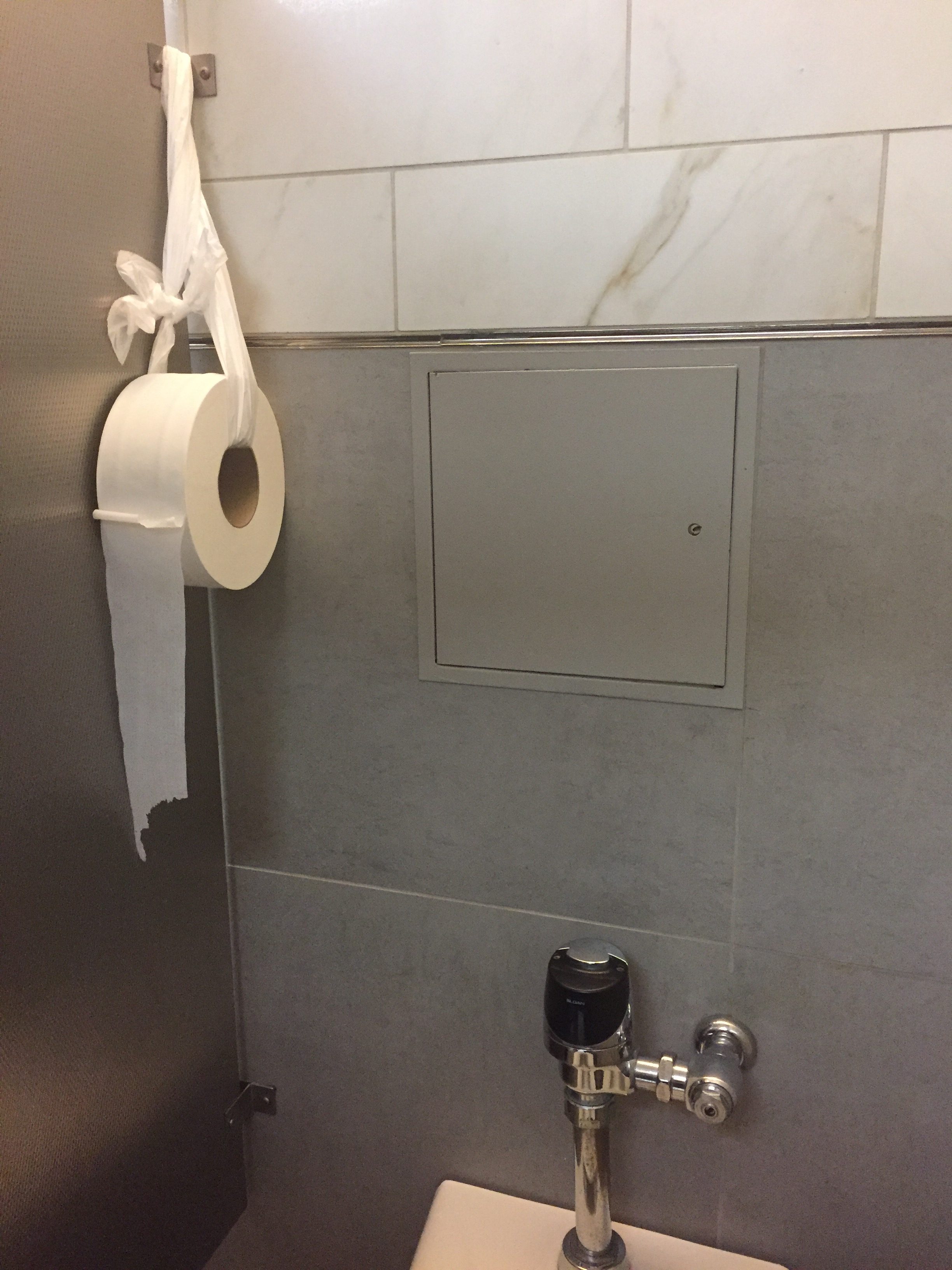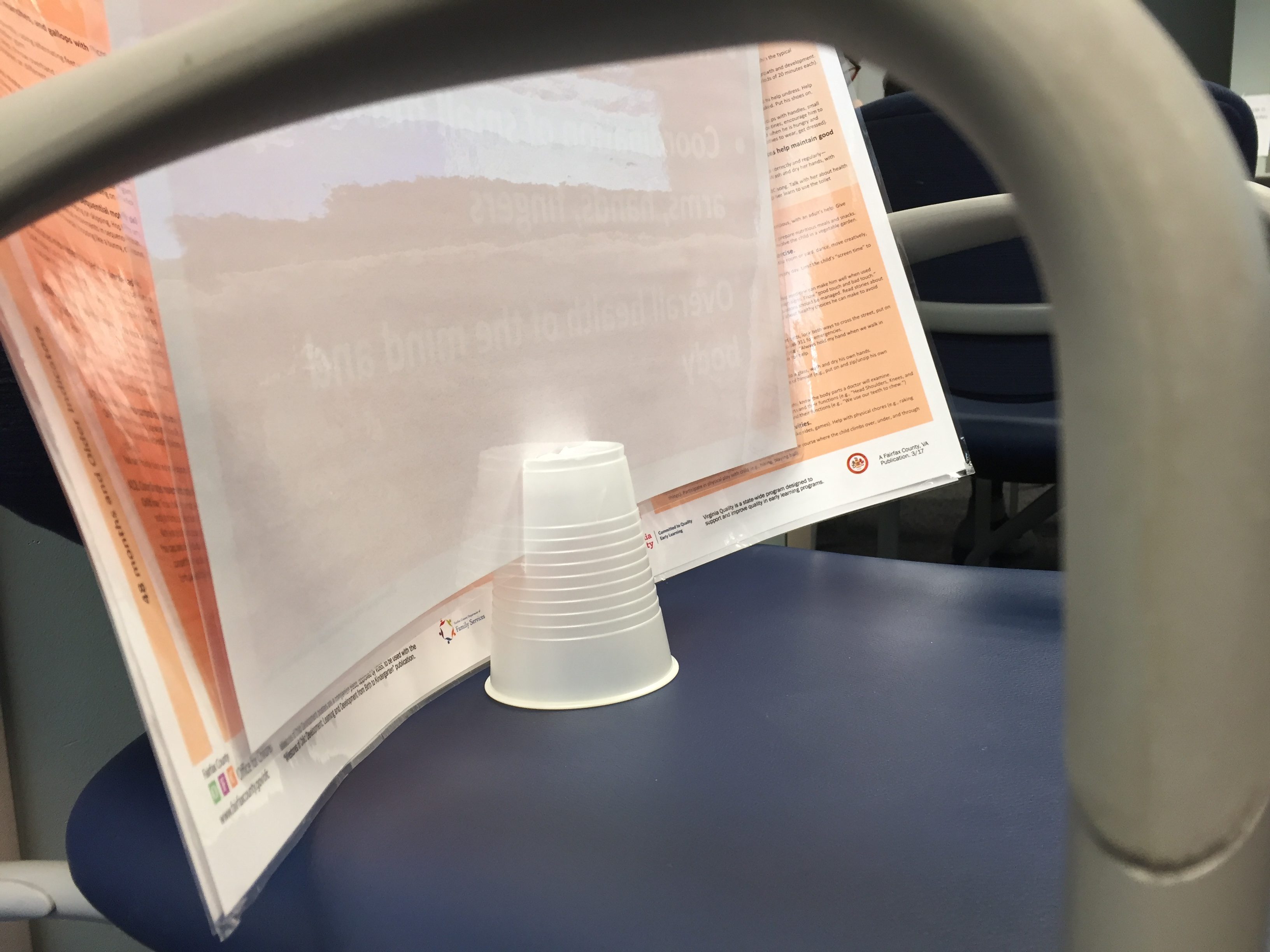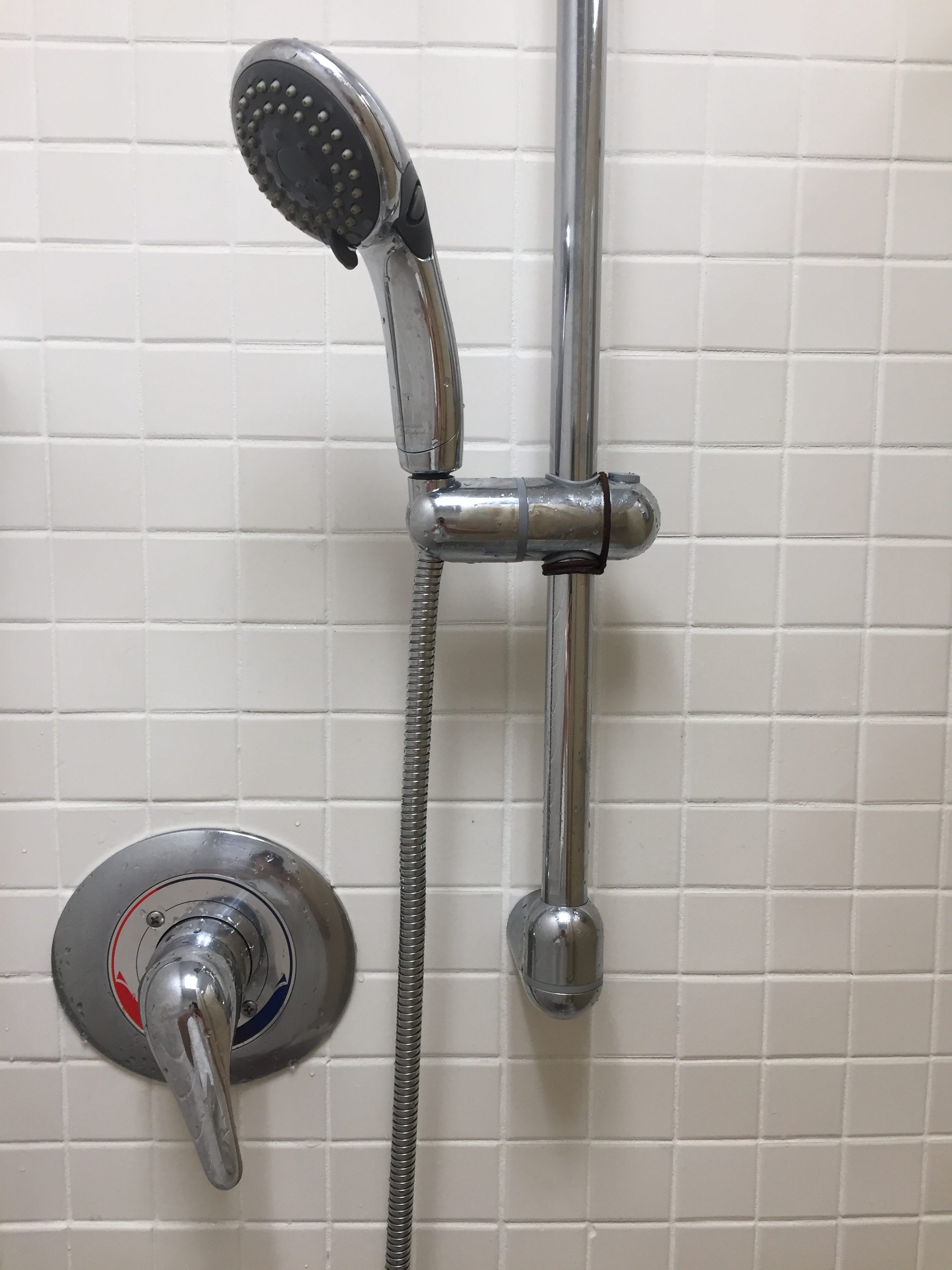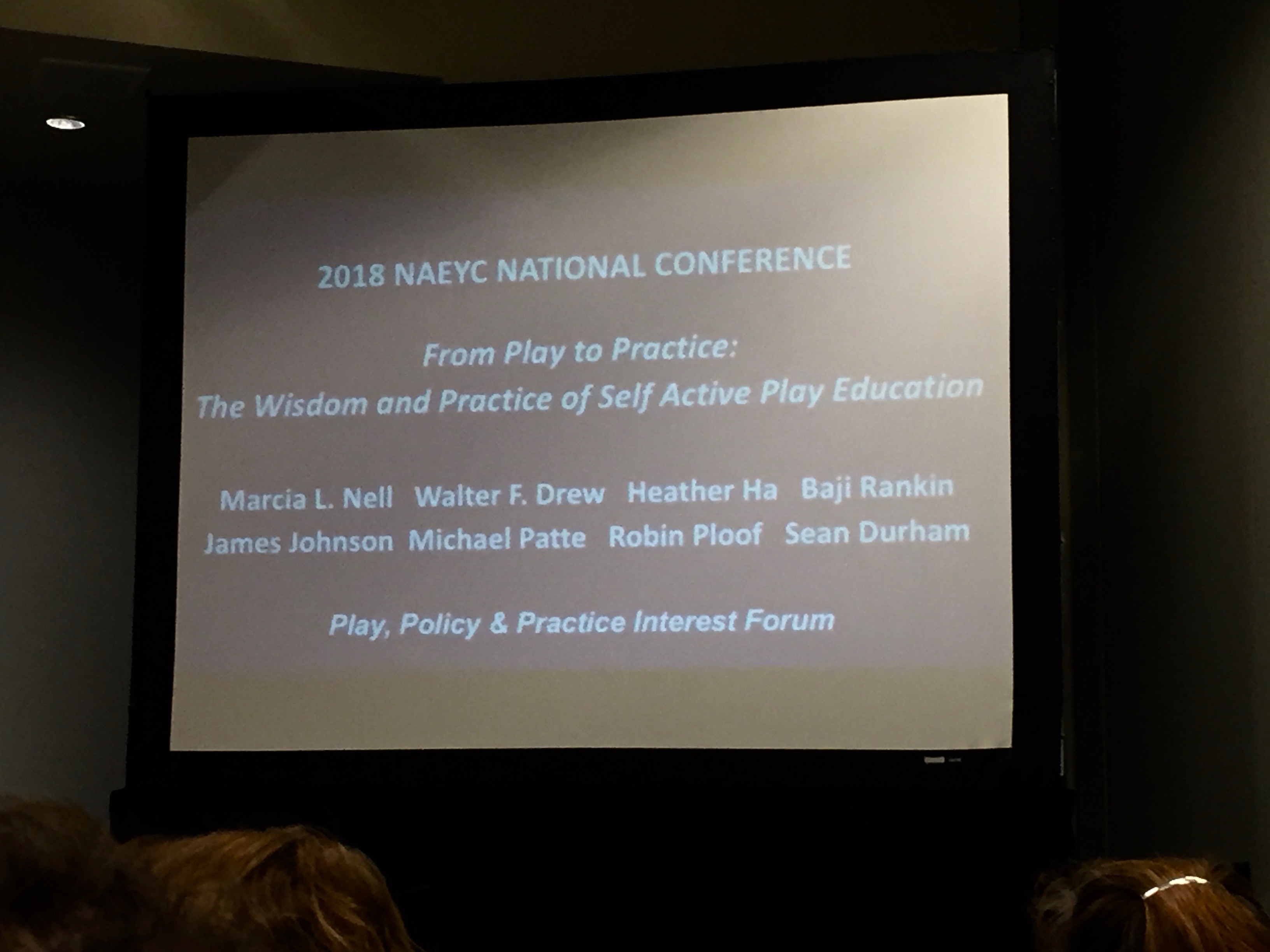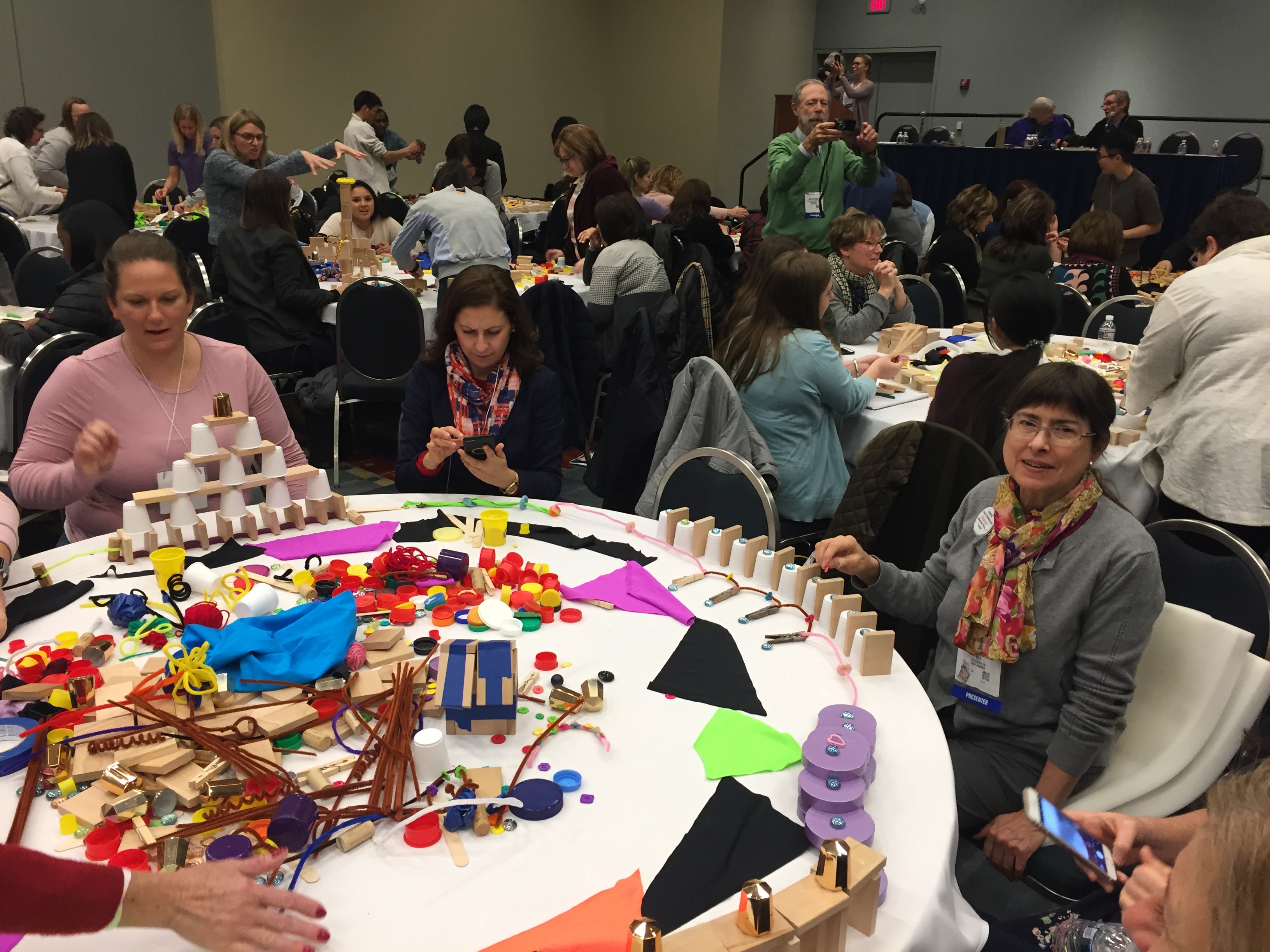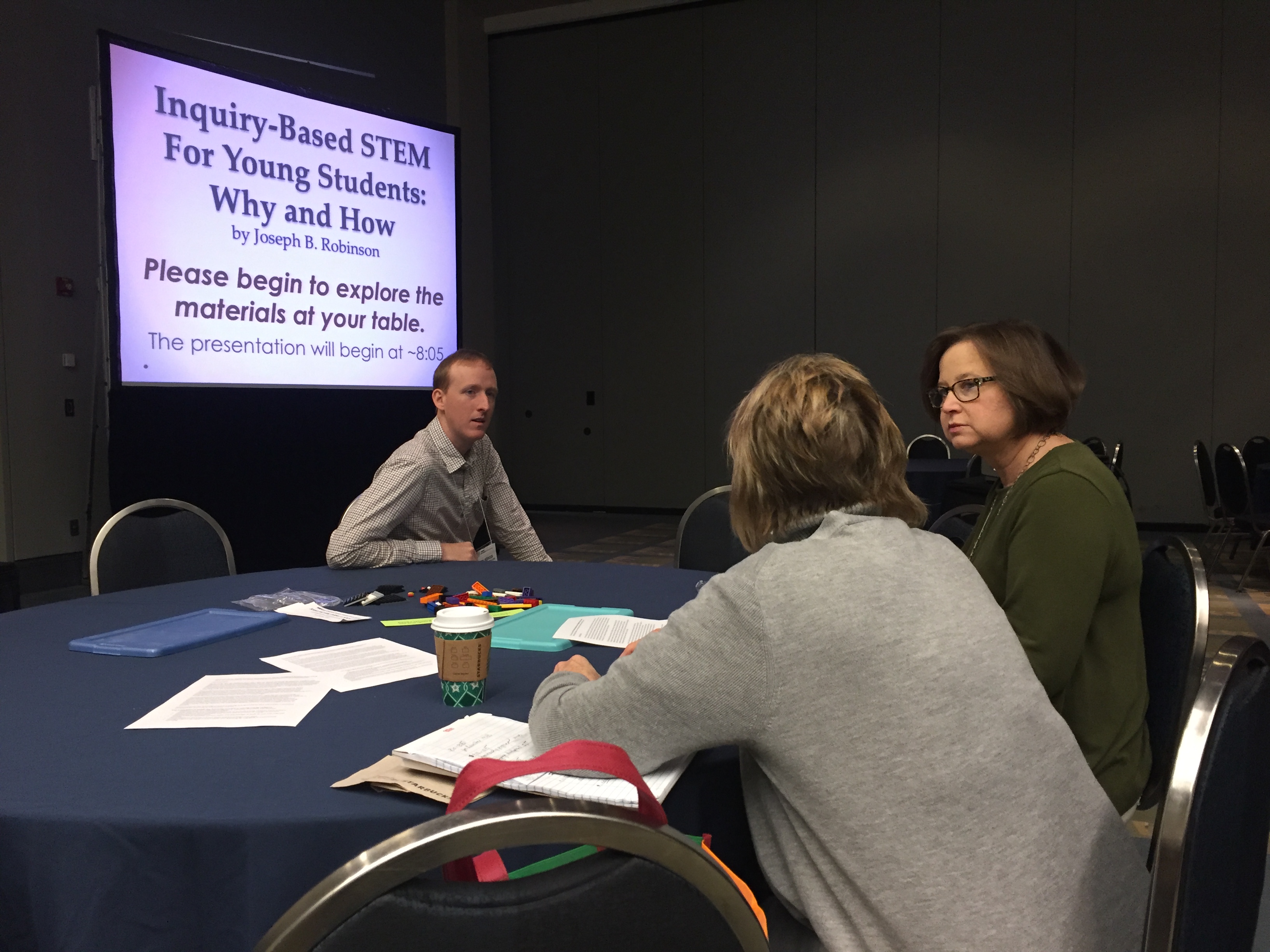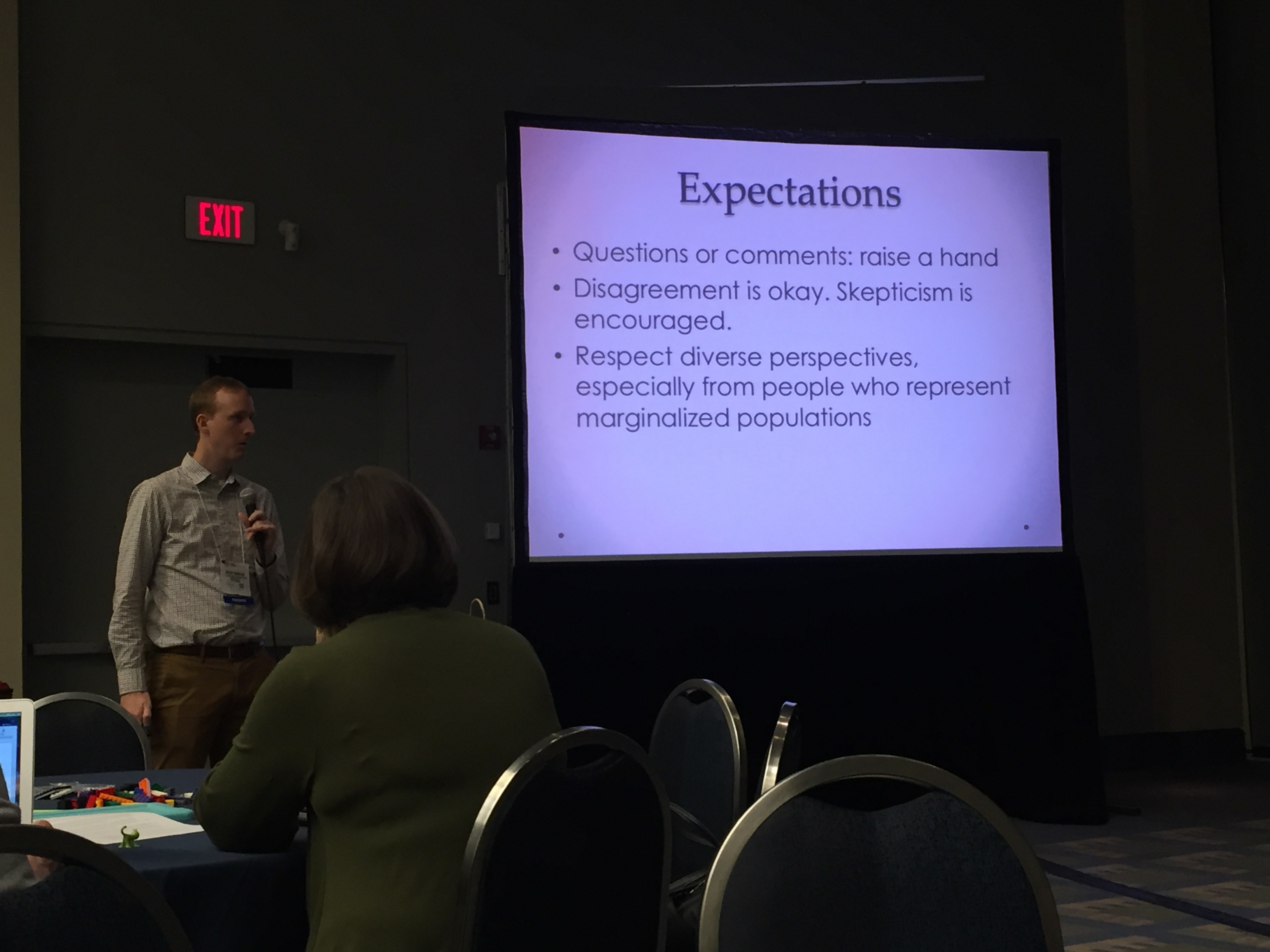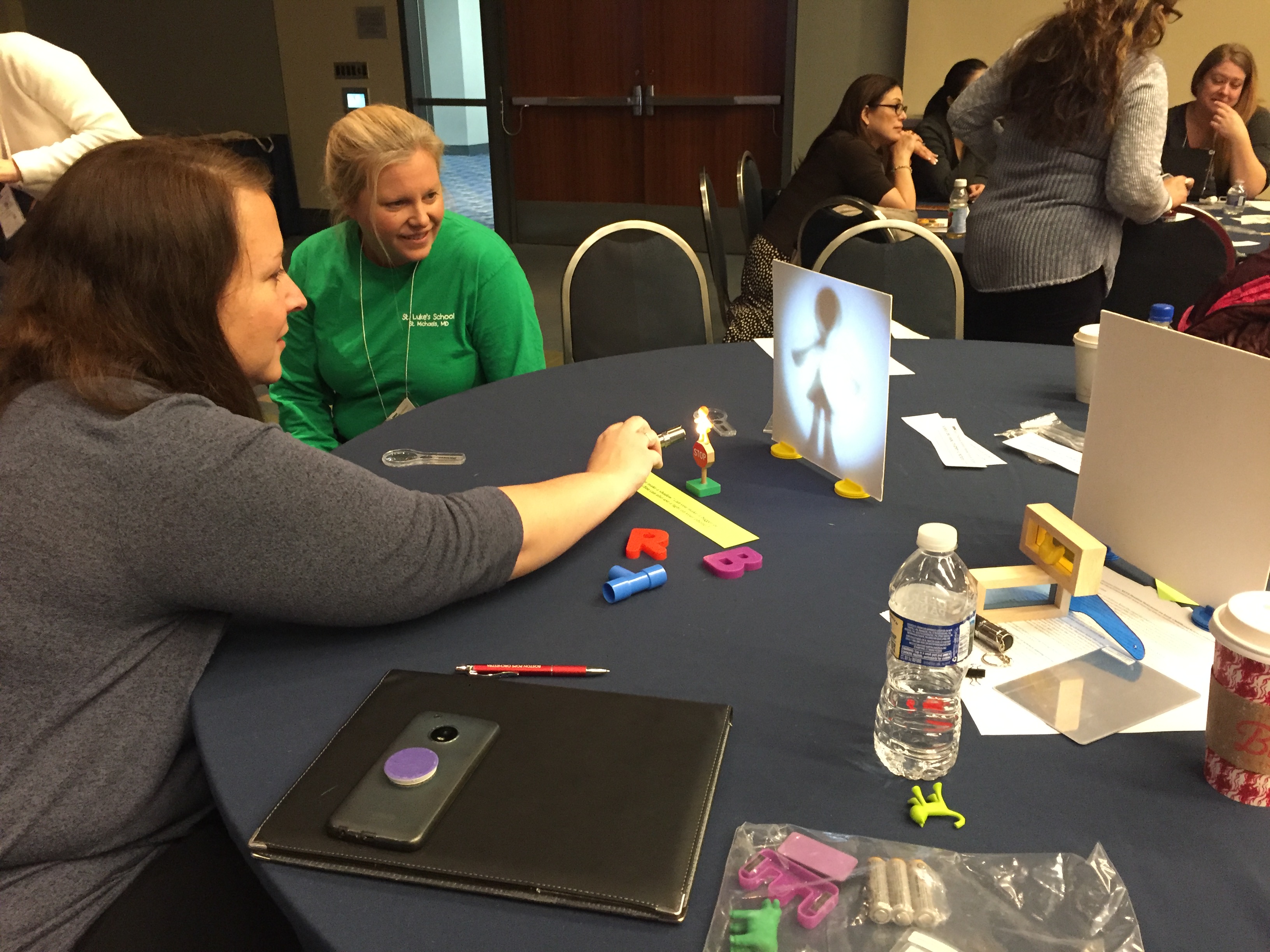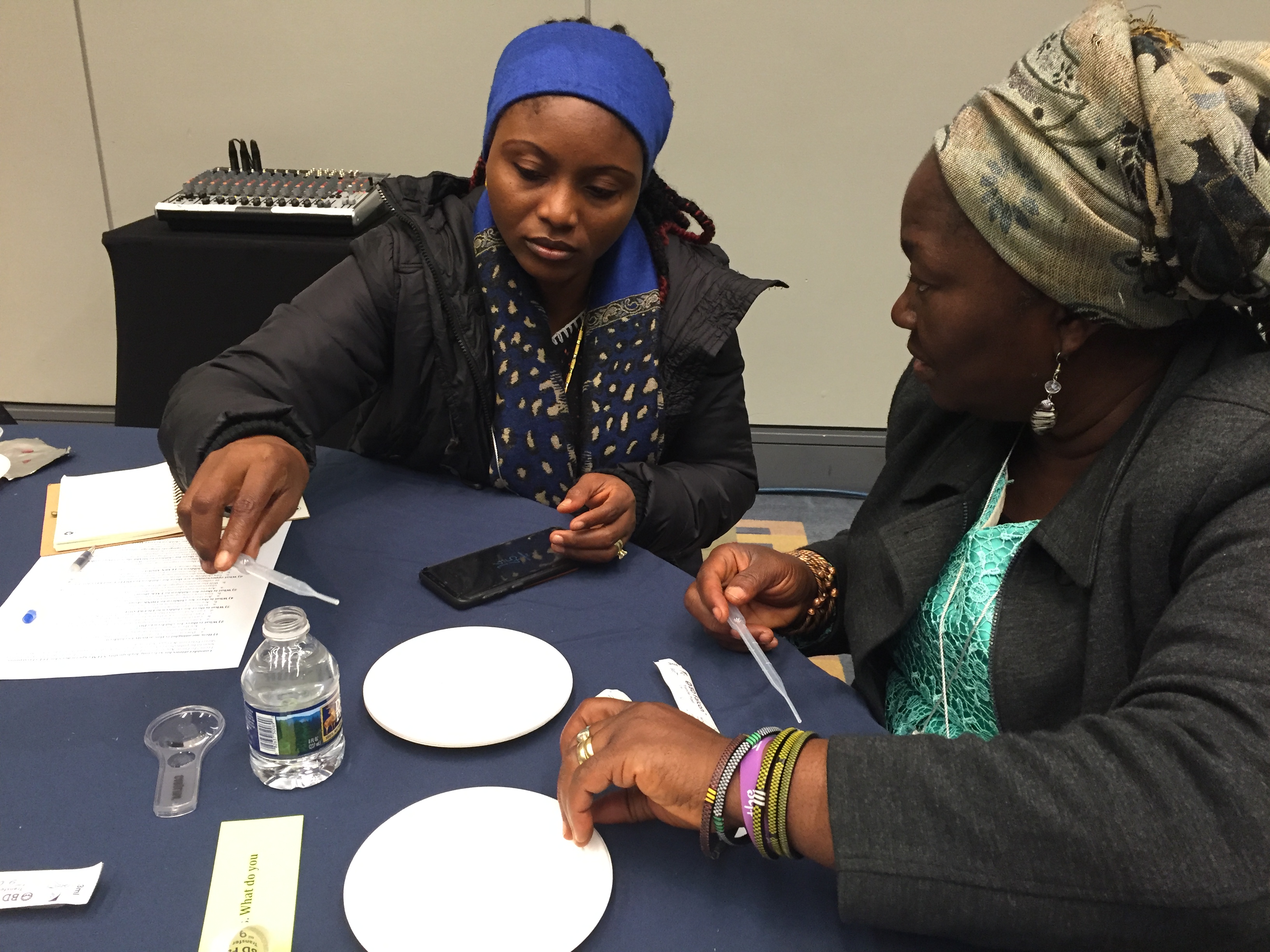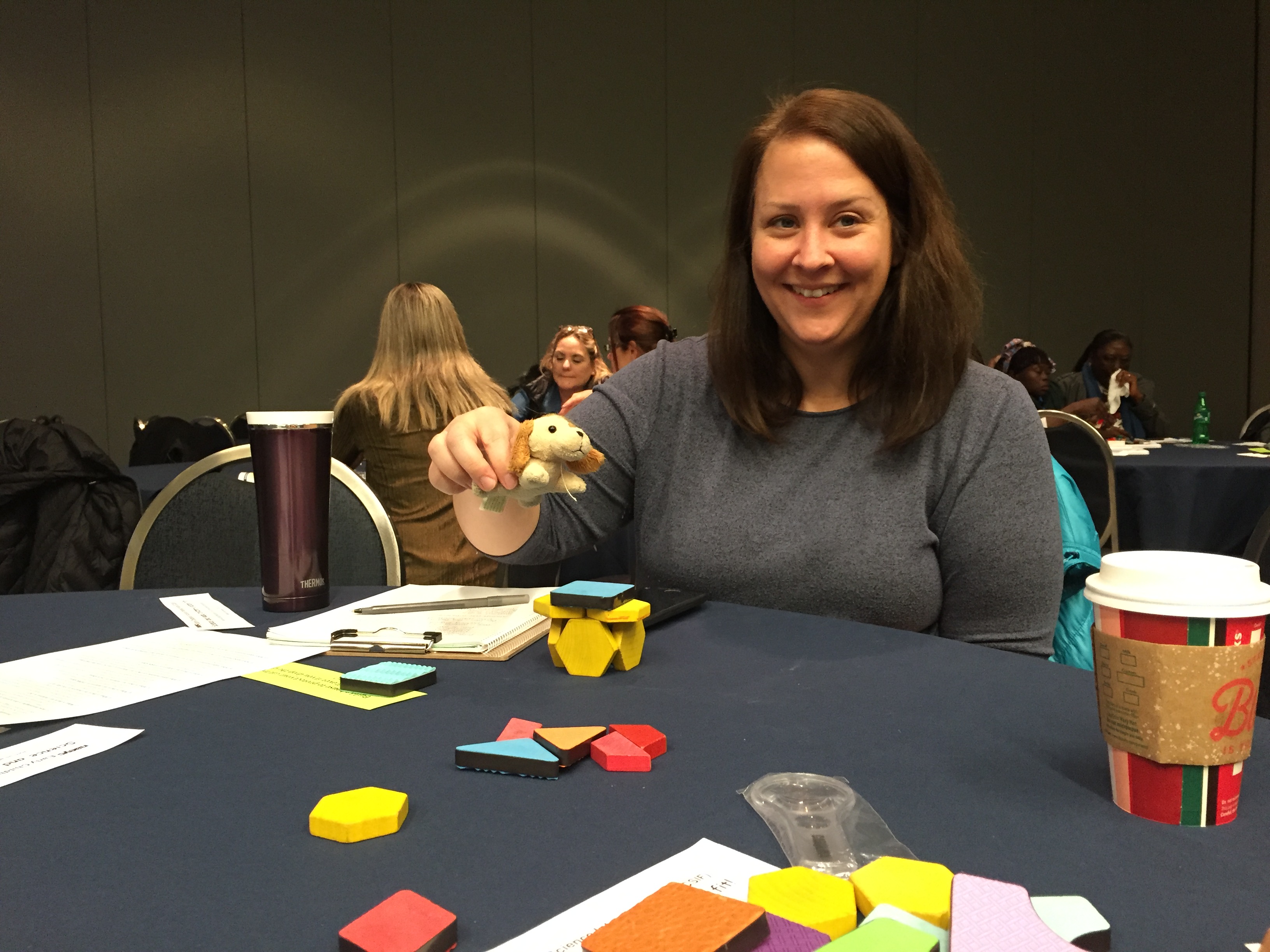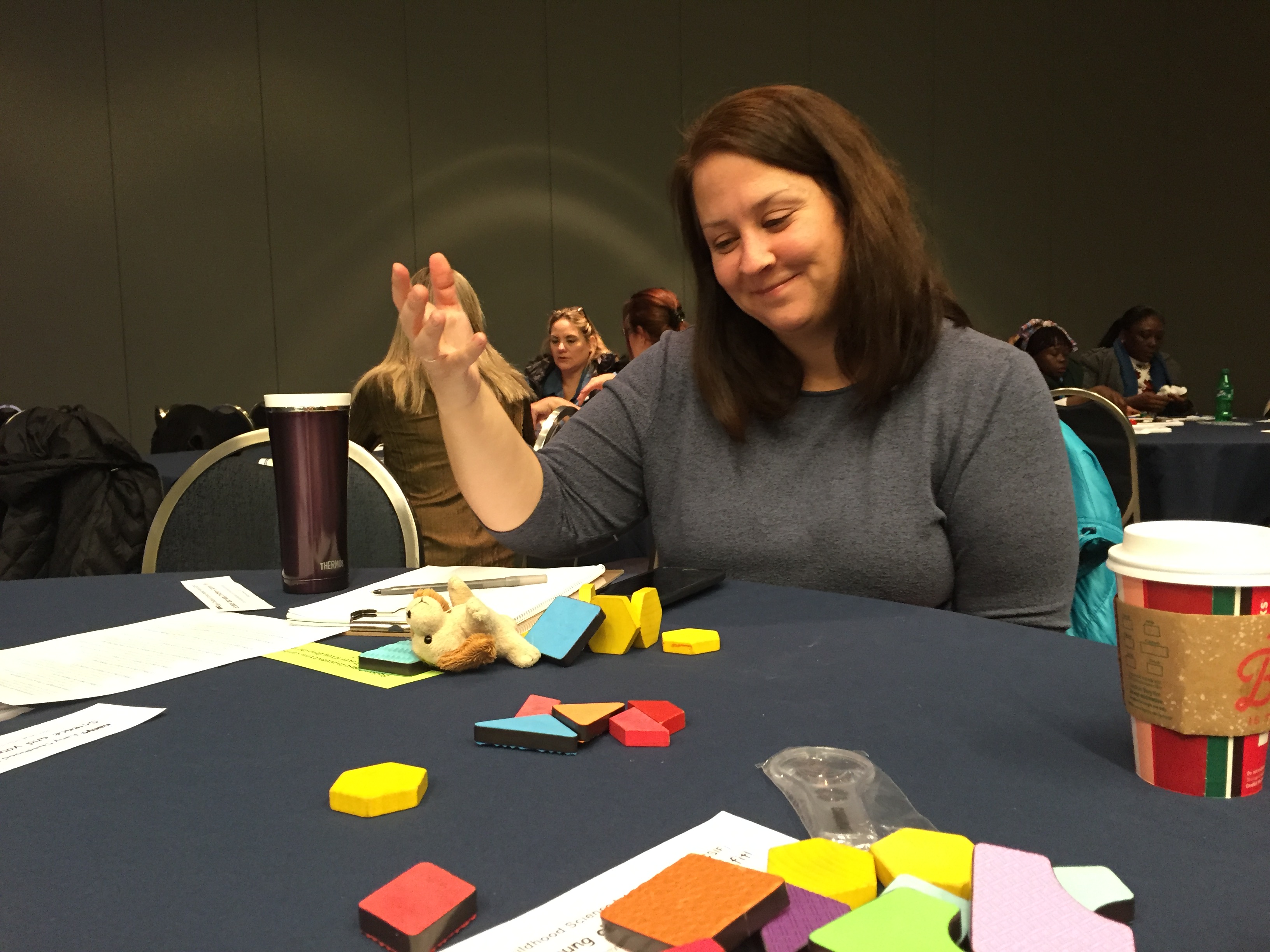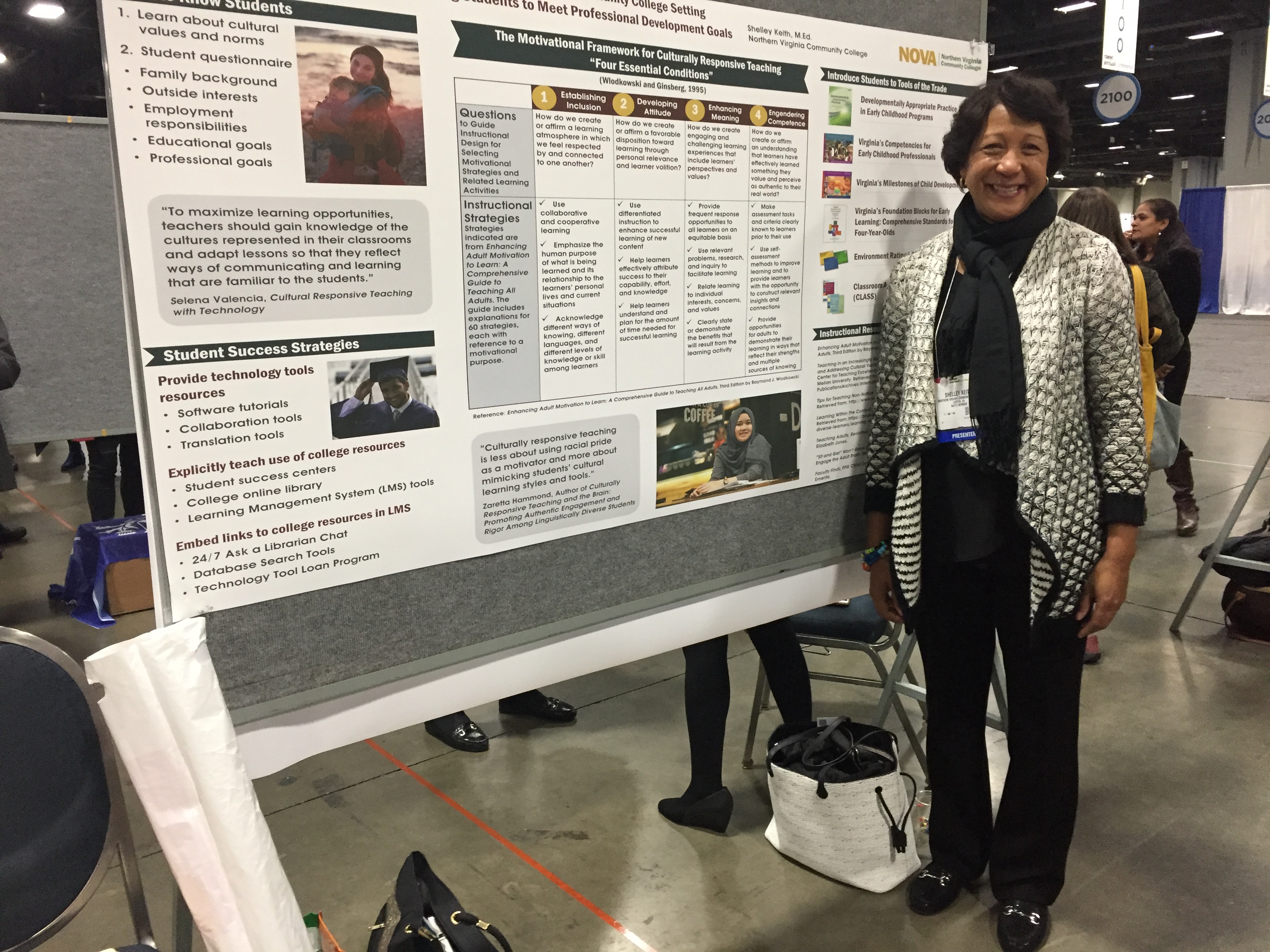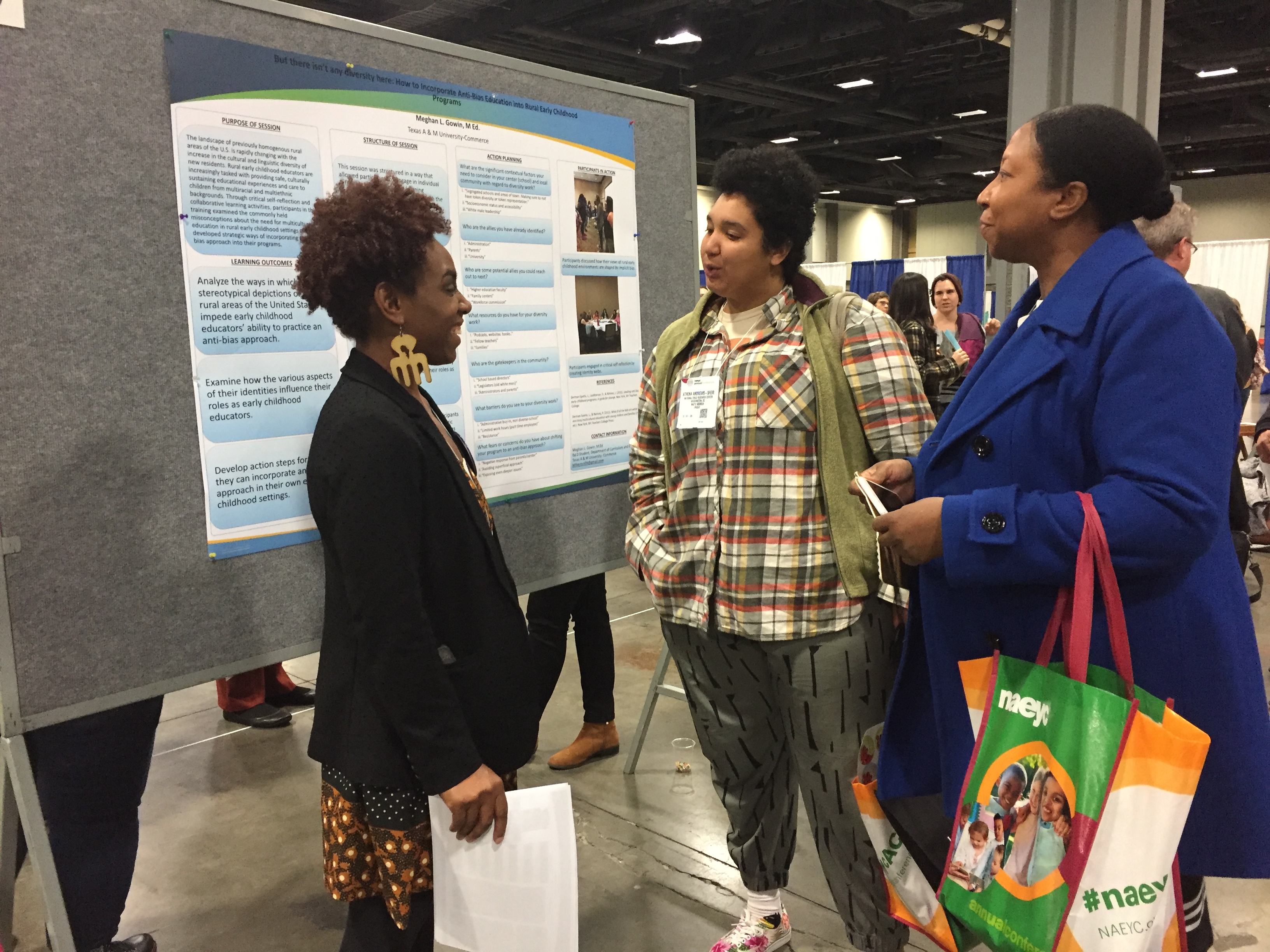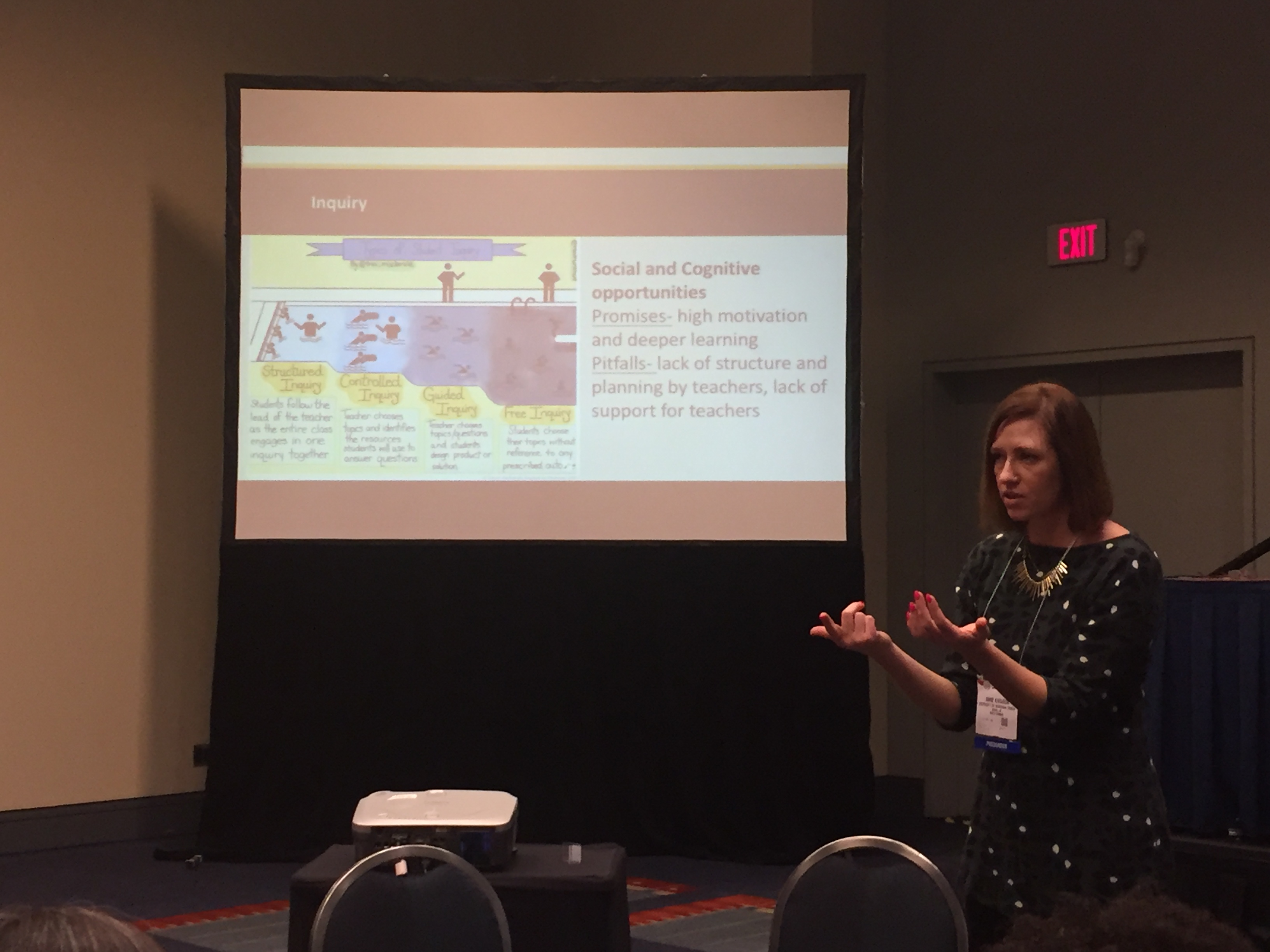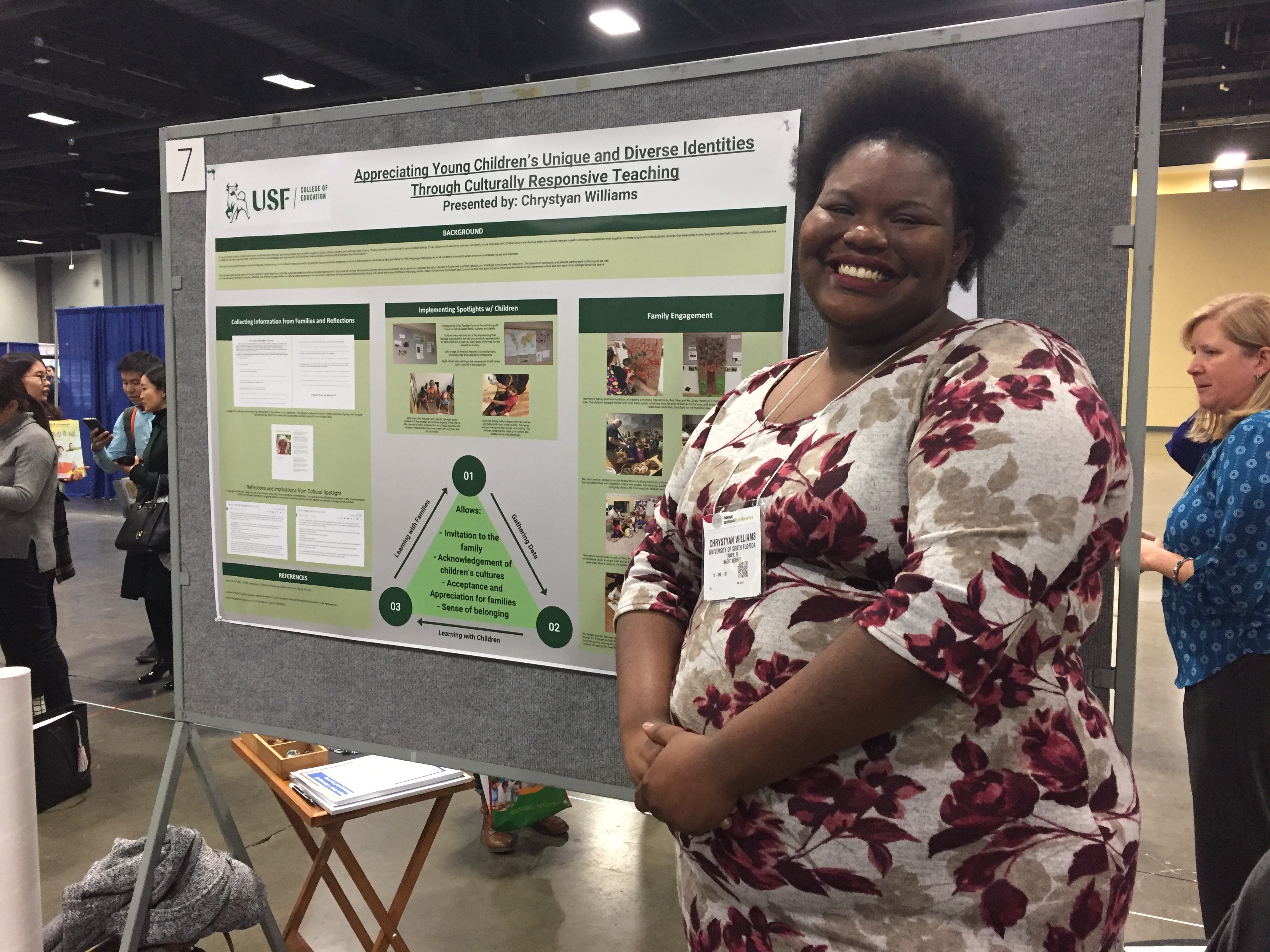Engineering in early childhood
By Peggy Ashbrook
Posted on 2018-12-15
In early childhood settings both educators and young children solve problems using available materials and an engineering design process. The process is not step-by-step because it looks different depending on the age of the children, the time available, and their engagement with adults helping them reflect on their work and process. A quick internet search for “The Engineering Design Process” shows that there are many variations, and they all include “evaluate” and “redesign” or “improve” as part of the process, and most of them are labeled “The” rather than “An” engineering design process. “Communicate” is another common part of the process, located centrally in some designs and often as a single moment. Some graphics communicate how the cycle repeats, the iterative nature of engineering design in working towards a better solution.
This cycle of trying to create a solution, testing it, then finding it needs some changes is familiar to most of us as we jury rig to deal with everyday problems. A childcare provider whose home business meets the needs of families with children five-years-old and under found that in addition to providing a stable step for small children to use at the sink, she also needed to move the water stream closer to the children. She devised this inexpensive homemade solution after trying several other designs: a just-the-right-size cup with the bottom removed, placed over the faucet to direct the water stream forward. Other homemade problem-solving designs by adults that I’ve seen include a way to hang a roll of toilet paper, a paper stand made from a cup, and using a hair rubber band to hold up a shower hose.
“Children have their own creative ideas to build and are intrinsically compelled to act upon them. In their process of construction, children grapple with systems thinking, growing to understand that the effect of changing one part of the system may have unintended consequences for the performance of another. They problem solve and often communicate with peers to collaborate in their perseverance to be successful. In the process, children have the opportunity to wrestle with their ethical use of materials and navigate social relationships.
Just as effective science teachers look for science in their children’s world to find meaningful entry points for science investigations, elementary teachers can look for engineering in their children’s world to find meaningful entry points for engineering experiences.” —Dr. Beth Van Meeteren
2018. Guest Editorial: Elementary Engineering: What Is the Focus? Science and Children. 55(7): 6-8.
What problems that arise in your setting have children tried to solve through an engineering design process? Making their own bandage or bag? Building a stable tower? Or creating a fair way—a system—to share materials? By identifying this kind of engineering design work you’ll be better able to help children reflect on their design and extend their work to improve it.
In early childhood settings both educators and young children solve problems using available materials and an engineering design process. The process is not step-by-step because it looks different depending on the age of the children, the time available, and their engagement with adults helping them reflect on their work and process.
Ed News: How Much Influence Do Teachers Have in Their Schools?
By Kate Falk
Posted on 2018-12-14

This week in education news, Baltimore resident is using the city’s bike culture to introduce more children to STEM; climate change is still just starting to make its way into classrooms, and many teachers don’t have the training or the resources they need to teach it; Education Department releasing a plan to help teachers who have been wrongly hit with debts because of troubled grant program; Minnesota teachers welcome proposed science education standards that would teach that humans are the primary cause of climate change; new study says scientists are leaving academic work at unprecedented rate; physical computing has established a presence in a small number of schools around the country; and report finds that 96 percent of principals surveyed feel that teachers are involved in making important school decisions, while only 58 percent of teachers do.
Bridging the Gap Between Science and Government
Research universities rely on government agencies for funding, but the latest word on those agencies’ science policies doesn’t reach campuses instantly. That’s why a few universities have created senior leadership roles dedicated to communicating between Capitol Hill and campus research laboratories. Read the article featured in The Chronicle of Higher Education.
Brittany Young remembers Sundays in West Baltimore as a child, when she’d hear the distinct buzzing and revving of engines. It was the city’s signature soundtrack for the summer, a sound that said: It was dirt bike season. Still, in the city long considered the capital of dirt bike culture, the sport endures. And Young, an elementary school technology instructor and former chemical engineer, is tapping into that love as a platform for something bigger. Through her grant-funded B-360 program, Young is using bike culture to introduce more black children to science, technology, engineering and mathematics. At the same time, she hopes to decrease street riding in Baltimore and to challenge the negative perception of this popular hobby. Read the article featured in The Baltimore Sun.
In Many Schools, ‘Climate Change Is Playing Catch-Up
If the world doesn’t make “rapid” and “unprecedented changes in all aspects of society,” a UN report warned this month, the effects of climate change will be dramatic and far-reaching — and not in some distant future, in the next 20 years. Even now, though, in most schools, climate change is still just starting to make its way into classrooms, and many teachers don’t have the training or the resources they need to teach it. Listen to the segment featured on WGBH.org.
Ed Department To Erase Debts Of Teachers, Fix Troubled Grant Program
For public school teacher Kaitlyn McCollum, even simple acts like washing dishes or taking a shower can fill her with dread. She and her family recently moved to a much smaller, older house. One big reason for the downsizing: a $24,000 loan that McCollum has been unfairly saddled with because of a paperwork debacle at the U.S. Department of Education. But for McCollum and many public school teachers, it appears the nightmare is nearly over. Listen to the segment featured on NPR.org.
Teachers Back New MN Climate Education Standards, But Topic’s Still Hot
Kay Nowell is a veteran science teacher in the St. Michael-Albertville public schools. Still, she feels the need to tread lightly when the topic of climate change comes up in her classroom. Despite the facts, teaching climate change can bring a political backlash from parents and others who doubt the science. It’s one reason why Nowell and teachers across the state are welcoming proposed science education standards that would, for the first time in Minnesota, teach that humans are the primary cause of climate change. Read the article featured in MPR News.
$4.4M in grant funds help California administrators improve STEM instruction
Four California school districts, three schools and three county offices of education have received a total of $4.4 million in state grants to improve STEM instruction, with a special emphasis on strengthening administrators’ ability to recruit highly qualified teachers in those subject areas and provide professional development to existing staff members. Read the brief featured in Education DIVE.
New Study Says Scientists Are Leaving Academic Work At Unprecedented Rate
The “half-life” of academic scientists has shortened dramatically over time, says a new paper calling attention to the “rise of the temporary workforce.” Following scientists in three fields, the paper’s authors found that it took about five years for a half of a science cohort to leave academic work in 2010 — compared to 35 years in the 1960s. Read the article featured in Inside Higher Ed.
K-12 Interest Grows in ‘Physical Computing’ as Hands-On Approach to Computer Science and STEM
Physical computing, an instructional strategy that tries to teach students about computer science and computational thinking through physical tools and hands-on activity, has established a presence in a small number of schools around the country. In many cases, there’s just one teacher or administrator who’s trying it, but supporters of the concept believe its role will grow. At the same time, they acknowledge that there are obstacles to implementing these types of programs, including concerns about the cost of applying it in classrooms, and the training educators need to make it happen. Read the article featured in Education Week.
How Much Influence Do Teachers Have in Their Schools? – It Depends on Whom You Ask
A growing body of research suggests that school management models emphasizing teacher influence in school governance have a range of benefits, including increased teacher job satisfaction, improved academic performance, and more-effective organizational learning. However, nationwide data from the American Educator Panels show that principals are significantly more likely to perceive that teachers have influence in their schools than teachers. Read the report by the RAND Corporation.
Higher education leaders, policymakers, and the private sector should take a range of actions to strengthen STEM programs and degree attainment in the nation’s Minority Serving Institutions (MSIs), says a new report from the National Academies of Sciences, Engineering, and Medicine. Read the press release.
Stay tuned for next week’s top education news stories.
The Communication, Legislative & Public Affairs (CLPA) team strives to keep NSTA members, teachers, science education leaders, and the general public informed about NSTA programs, products, and services and key science education issues and legislation. In the association’s role as the national voice for science education, its CLPA team actively promotes NSTA’s positions on science education issues and communicates key NSTA messages to essential audiences.
The mission of NSTA is to promote excellence and innovation in science teaching and learning for all.
Follow NSTA

Tackling Misconceptions and Personal Beliefs
By Gabe Kraljevic
Posted on 2018-12-14

How do you overcome misconceptions that many students will have coming into your classrooms? What is the best way to handle and approach situations when personal beliefs are involved?
— M., Arkansas
Misconceptions abound in almost every topic we could study in science! To help anticipate some common misconceptions search NSTA’s The Learning Center and other sources.
An excellent method to uncover misconceptions is to poll your students’ prior knowledge using a Know-Want to Know-Learned (KWL) activity. Use misconceptions and half-truths as springboards to teach the nature of science. Investigations that give empirical evidence are probably the most powerful way to combat misconceptions. Some misconceptions are difficult to prove in class so teach students how to differentiate between reputable and poor sources of information and data.
With respect to faith:
Your job is to teach science, not to produce a secular society. NSTA’s position statement on Teaching Science in the Context of Societal and Personal Issues (https://www.nsta.org/about/positions/societalpersonalissues.aspx) states that science instruction should:
- approach decisions based on scientific evidence in an open unbiased way, while acknowledging that different perspectives, views, beliefs, and other ways of knowing exist;
- prepare students to become future citizens who understand science and engineering and are willing to engage in making responsible and informed decisions.
It’s okay to tell your students that you will teach science and how science works in your classroom. I don’t believe that faith should have any footing in a science class much the same way that we don’t teach German in French language classes.
Hope this helps!

How do you overcome misconceptions that many students will have coming into your classrooms? What is the best way to handle and approach situations when personal beliefs are involved?
— M., Arkansas
Legislative Update
America’s Strategy for STEM Education
By Jodi Peterson
Posted on 2018-12-10
On December 4, 2018 the Trump Administration released a five year strategic plan for STEM education that calls for expanding the nation’s capacity for STEM education and preparing workers for jobs in the these fields, and charts out a strategy which federal agencies with STEM education initiatives can use when developing their programs.
The Administration also suggests the report is an urgent call to action on STEM education and should be considered a “North Star” that all STEM stakeholders can follow.
The report, titled Charting a Course for Success: America’s Strategy for STEM Education, is based on a vision where “all Americans will have lifelong access to high-quality STEM education and the United States will be the global leader in STEM literacy, innovation and employment.”
It was shepherded through an inter-agency process lead by Jeff Weld—a former science teacher and head of the Governor’s STEM Advisory Council in Iowa—who worked extensively with the STEM education community over the course of several months to develop the plan. (NSTA Executive Director David Evans is vice chair of the STEM Education Advisory Panel that is advising NSF/Committee on Science, Technology, Engineering and Mathematics Education (CoSTEM) on this report and other STEM education related issues.)
Here are some highlights from Charting a Course for Success: America’s Strategy for STEM Education.
The vision for a ensuring the United States becomes the global leader in STEM will be achieved by pursuing three goals:
- Goal 1: Build Strong Foundations for STEM Literacy
- Goal 2: Increase Diversity and Inclusion through Broader Access to STEM
- Goal 3: Prepare the STEM Workforce for the Future
The federal strategy for STEM education is built on four pathways:
Develop and Enrich Strategic Partnerships
Strengthen existing relationships and develop new connections between educational institutions, employers and communities by bringing together schools, colleges and universities, libraries, museums and other community resources to foster STEM Ecosystems. Increase work-based learning and training through partnerships of educators and employers, and explore opportunities to blend formal and informal learning with curricula so students can complete both core academic and applied technical curricula in preparation for higher education.
Engage Students where Disciplines Converge
Make STEM learning more meaningful and inspiring to study by engaging learners in transdisciplinary activities such as project-based learning, science fairs, robotics clubs, invention challenges and gaming workshops. Make mathematics a magnet, not a barrier, to the further study of STEM subjects. Teach learners to tackle problems using multiple disciplines.
Build Computational Literacy
Advance computational thinking as a critical skill for today’s world and make it and integral part of all education. (Computational thinking is defined as including computer science, but not just using computing devices effectively; it means solving complex problems with data). Expand the use of digital platforms for teaching and learning that enable anytime/anywhere learning; make individualized instruction possible; and offer engaging learning through simulation-based activities and virtual reality experiences.
Operate with Transparency and Accountability
The federal government must use open, evidence-based practices and decision making in STEM programs, investments, and activities. Specifically, it calls for federal agencies to:
- Leverage and Scale Evidence-Based Practices Across STEM Communities
- Report Participation Rates of Underrepresented Groups
- Use Common Metrics to Measure Progress
- Make Program Performance and Outcomes Publicly Available
- Develop a Federal Implementation Plan and Track Progress
Federal agencies with STEM programs will be developing their plans to implement the goals outlined in this plan in the next few weeks.
Vignettes of best practices and profiles of effective federal STEM programs are sprinkled throughout the report. The Army Educational Outreach Program (AEOP) was cited as a best example for Documenting the Participation of Underrepresented Students in STEM programs (sidebar, page 30). NSTA administers several programs for AEOP, including eCYBERMISSION, Gains in the Education of Mathematics and Science (GEMS), the Junior Science and Humanities Symposium (JSHS), and oversees the Camp Invention sites that are sponsored by AEOP.
Under the section Blend Successful Practices from Across the Learning Landscape, NSTA’s Connected Science Learning is cited as an online community resource that “shares effective practices and research for bridging the gap between in-school and out-of-school settings” (page 13 of the report).
The report can be found here.
Read articles about the report:
EOS: White House Releases STEM Education Strategy
Education Week: Trump Team Outlines Its STEM Education Vision
Education DIVE: White House releases five-year STEM education strategy
Science magazine: Trump emphasizes workforce training in new vision for STEM education
Stay tuned, and watch for more updates in future issues of NSTA Express.
Jodi Peterson is the Assistant Executive Director of Communication, Legislative & Public Affairs for the National Science Teachers Association (NSTA) and Chair of the STEM Education Coalition. Reach her via e-mail at jpeterson@nsta.org or via Twitter at @stemedadvocate.
The mission of NSTA is to promote excellence and innovation in science teaching and learning for all.
Follow NSTA
On December 4, 2018 the Trump Administration released a five year strategic plan for STEM education that calls for expanding the nation’s capacity for STEM education and preparing workers for jobs in the these fields, and charts out a strategy which federal agencies with STEM education initiatives can use when developing their programs.
The Administration also suggests the report is an urgent call to action on STEM education and should be considered a “North Star” that all STEM stakeholders can follow.
Ed News: Using Teacher-Leaders to Improve Schools
By Kate Falk
Posted on 2018-12-07

This week in education news, students chalk up three times the learning gains in classrooms with the most effective teachers; virtual reality can be a powerful tool for improving environmental learning gains and attitudes; new report finds climate change may have a more permanent, major impact on the future of learning; a key method to support skill development without taking away content time is to embed supports; new survey reveals that two in 10 teachers said their students are not taught any computer science; and for co-teaching to work, teachers need time, training, and resources to effectively integrate their distinct instructional expertise; and managers have a hard time hiring and keeping millennials.
Using Teacher-Leaders to Improve Schools
Edgecombe County Public Schools in rural North Carolina has long had trouble filling all of its open teaching positions. Historically, there just hasn’t been enough interest among qualified candidates. But that’s changing. Read the article featured in The Hechinger Report.
Virtual Reality Could Serve as Powerful Environmental Education Tool
Utter the words “ocean acidification” in mixed company, and you’ll probably get blank stares. Although climate change has grown steadily in the public consciousness, one of its most insidious impacts – a widespread die-off of marine ecosystems driven by carbon dioxide emissions – remains relatively unknown. Enter virtual reality. Read the article featured in Science Daily.
Report: Climate Change and Migration Will Impact the Future of Schools
Raging wildfires in California and devastating hurricanes along the Atlantic seaboard have sent school officials scrambling to resolve immediate problems, such as repairing infrastructure and finding new schools for displaced students. Longer term, climate change may have a more permanent, major impact on the future of learning, according to a new report. Read the article featured in EdSurge.
TIME’s 2018 Person of the Year? How About the American Teacher?
In American education, 2018 has been the year of the teacher. It was this year that long-timid American teachers stood up by the tens of thousands in a handful of states to strike for better pay and for more funding for sorely under-resourced schools. The strikes were largely in Republican-led states, and led by teachers rather than their unions. They followed years of plummeting morale among teachers because of what they saw as oppressive federal and state policies targeting them and their profession. Read the article featured in the Washington Post.
Supporting Literacy in the Science Classroom
Written and spoken language play a significant role in all classes. But if you’re trained as a science teacher, how do you support literacy development without losing content time for science? Read the article featured in edutopia.
In a New Survey, Teachers Say There’s a Disconnect in Computer Science Education
Is there a disconnect in current efforts to teach computer science? Some teachers think so. In a new survey, 88 percent of teacher respondents said they believe computer science is critical for students’ success in the workplace—but two in 10 teachers said their students aren’t taught any computer science. Read the article featured in EdSurge.
What It Takes to Make Co-Teaching Work
In Lauren Eisinger and Kara Houppert’s co-taught 5th grade classroom, every instructional choice requires a lot of planning. When Eisinger, a special education teacher at Naples Elementary School in upstate New York, and Houppert, a 5th grade teacher, wanted to start a class book club last year, they knew they would have to think creatively to accommodate reading levels spanning 2nd to 6th grades. Read the article featured in Education Week.
K-12 Students Should be Taught Climate Science, Teachers’ Association Says
Teachers across the country have no qualms explaining the facts of physics or chemistry. And, according to the National Science Teachers Association, climate change should not be any different. Read the article featured in YALE Climate Connections.
Millennial Teachers: Things to Consider in Trying to Recruit and Retain Them
Managers in many professions—including those working for school systems—share a common topic of complaint these days: challenges around hiring and keeping millennials. That generation, generally defined as those born between 1981 and 1996, has been stereotyped unflatteringly as self-absorbed, entitled, and obsessed with technology to an unhealthy extent. The group also makes up large proportion of today’s eligible workforce. Read the article featured in Education Week.
Stay tuned for next week’s top education news stories.
The Communication, Legislative & Public Affairs (CLPA) team strives to keep NSTA members, teachers, science education leaders, and the general public informed about NSTA programs, products, and services and key science education issues and legislation. In the association’s role as the national voice for science education, its CLPA team actively promotes NSTA’s positions on science education issues and communicates key NSTA messages to essential audiences.
The mission of NSTA is to promote excellence and innovation in science teaching and learning for all.
Follow NSTA

Absentee Student
By Gabe Kraljevic
Posted on 2018-12-07
 One student in the class I currently teach has only been present one day out of four weeks. How should I keep this student up to date with the work that he is missing? Any tips and advice are greatly appreciated!
One student in the class I currently teach has only been present one day out of four weeks. How should I keep this student up to date with the work that he is missing? Any tips and advice are greatly appreciated!
— O., Ohio
Talk to your cooperating teacher to learn what strategies have been used in the past and how assessments and grading have been handled. Also, find out if any communications with the family have occurred and if there is support at home for the child to catch up. As a student teacher, you should leave these communications to the cooperating teacher and I strongly advise against giving the family your e-mail or direct contact information.
Since this student is chronically absent, you should keep notes of the lessons and activities he has missed and collect any handouts in a folder. If the student frequently loses or forgets the work he does get, then don’t send work home—keep a binder in class for him.
You can also be a little proactive and differentiate your teaching for this student as having a special need. Assemble booklets or binders of material that the student can work through at his own pace. These binders will be very useful on the days the student is present and you are in the middle of a project or an intensive class activity. Similarly, prepare some take-home activities that can replace in-class labs and hands-on work.
Hope this helps!
 One student in the class I currently teach has only been present one day out of four weeks. How should I keep this student up to date with the work that he is missing? Any tips and advice are greatly appreciated!
One student in the class I currently teach has only been present one day out of four weeks. How should I keep this student up to date with the work that he is missing? Any tips and advice are greatly appreciated!
— O., Ohio
Did You Get My Message?
By Carole Hayward
Posted on 2018-12-04
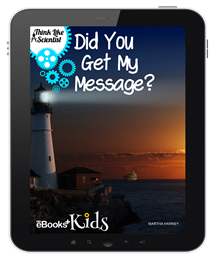 Curiosity and non-conformity are two traits that have served science educator and eBooks+ Kids author Martha Harney very well throughout her professional life.
Curiosity and non-conformity are two traits that have served science educator and eBooks+ Kids author Martha Harney very well throughout her professional life.
Harney, an elementary science specialist for the Northeast Elementary School in Waltham, Mass., grew up among people who instilled in her a lifelong love for learning new things.
“For me, the curiosity was always there,” she said.
Harney’s path to the teaching profession followed a circuitous journey. In college she majored in French. She operated her own DJ business while her children were young, giving her more time to spend with them during the day because she worked nights. Upon completing a teacher certification program, she first taught English to adults. Then she became a “roaming scientist” offering educational programming across many schools.
Approximately five years ago, while being well-established into her elementary science career, Harney applied for and was accepted into the Boston-based Museum of Science Teacher-in-Residence Program. There she met a fellow teacher-in-residence who introduced her to the NGSS@NSTA Curator program. She entered the competitive application process and was accepted into nationwide cadre of educators tasked with establishing a library of NGSS-aligned and vetted resources that teachers could use to help make the necessary instructional shifts to align their teaching with the new standards.
“The NGSS encourage curiosity rather than the memorization of facts,” said Harney. “The ‘correct’ answer doesn’t matter as much as the process required to conduct the type of investigation which leads students to the answer,” she explained.
The expertise Harney gained from becoming an NSTA Curator helped her realize that many teaching and learning resources are “stamped with the NGSS label, but do not necessarily align with the standards and/or do what they are intended to do.” She knew that science educators needed richer resources, and Harney found a great way to bring them one—by writing an NSTA eBook+ Kids.
“I’ve had a lot of books in my head for years,” Harney said, so when she received an email for NSTA seeking book ideas, she jumped at the idea.
Her eBook, Did You Get My Message? allows first graders to explore communication systems, and learn how each has both benefits and drawbacks. Specifically, the content focuses on how sights and sounds help us to send and receive messages. By exploring this eBook, students discover that usage is determined by the method that works best for the situation, and will be able to design their own communication devices after reading it.
Given that she’d taught her own first grade students how to design communications devices, the topic was also a natural one for her to explore in an eBook.
“I started with fire trucks—kids love fire trucks!—because I wanted students to design communications devices that featured light and sound,” she explained. “My students and I watched lots of videos about firetrucks and talked about how they were sending out information via their flashing lights and honking horns. And then I gave them the opportunity to design and build their own communications devices, ones that would give directions across the room.”
The eBook includes messages that students can encode or decode as well as send. Additional opportunities are provided, via the accompanying teacher’s guide, for educators to extend learning beyond the eBook and into the classroom.
Harney credited NSTA’s creative publishing team as well as her own students for making her eBook a truly collaborative effort.
“I was writing the book last year, and during the school day, I would talk to my students about my content as it was progressing. They helped me write it and provided feedback when they thought that the content was confusing,” she said.
“It’s always a good sign if kids can ask if they take the material home with them to work on it more!”
Never one to stop learning and exploring new topics of interest, Harney shared that she’s already at work on a new eBook about waves for fourth graders.
Follow NSTA
 Curiosity and non-conformity are two traits that have served science educator and eBooks+ Kids author Martha Harney very well throughout her professional life.
Curiosity and non-conformity are two traits that have served science educator and eBooks+ Kids author Martha Harney very well throughout her professional life.
Harney, an elementary science specialist for the Northeast Elementary School in Waltham, Mass., grew up among people who instilled in her a lifelong love for learning new things.
Reimagining STEM for English Learners
By Kate Falk
Posted on 2018-12-03
Science, engineering, technology, and math (STEM) learning is for all students. STEM learning is essential in today’s classrooms because it arms our students with the knowledge and skills to process information, uncover problems, design solutions, collect data, evaluate evidence, and engage with technology.
STEM isn’t just experimenting in laboratories and solving complicated equations; our world depends on it. STEM promotes students’ inherent curiosity as they make sense of the natural world and solve problems in innovative ways to improve society. From making healthy, economical decisions at the grocery store to understanding the complexities of our universe, a rigorous and robust STEM education is imperative for our students to become knowledgeable, productive citizens and ready to enter the workforce.
The US Bureau of Labor and Statistics reported that employment in STEM occupations grew by 10.5% between May 2009 and May 2015, compared to only 5.2% growth in non-STEM occupations. The national average wage for all STEM occupations was $87,570, almost double the national average of non-STEM jobs at $45,700. Giving students access to quality STEM instruction won’t just open opportunities for them to be savvier critical thinkers, it can also open many opportunities for employment in the future. Unfortunately, our English learners (ELs) are woefully underrepresented in STEM fields. How can educators best prepare EL students to be ready for the STEM jobs of the future?
“It is essential to acknowledge that all children, irrespective of their home culture and first language, arrive at school with rich knowledge and skills that have great potential as resources for STEM learning.” – English Learners in STEM Subjects
Each and every student brings their own rich experiences and diverse culture to our classrooms. This is especially true for our English learners. Respecting our EL students’ diverse and rich culture—while providing them with an equitable and culturally relevant learning experience—is key to reinventing our classrooms and helping our students realize their potential. Language often appears to be a barrier to learning for English learners in the STEM classroom. This barrier is sometimes used as a catalyst for ELs not to have opportunities to engage in STEM learning, thus limiting their ability to be successful. How can we best leverage our English learners’ talents, knowledge, language, and experiences so they can be prepared to take advantage of all opportunities their futures may hold?
In October of 2018, The National Academies of Sciences, Engineering, and Medicine released its consensus report English Learners in STEM Subjects: Transforming Classrooms, Schools, and Lives. The report provides a rigorous, in-depth analysis of the research on ELs in STEM and language learning. It also details research-based recommendations for improving STEM learning outcomes for our PreK-12 students.
The report explores some important themes concerning ELs in its chapters:
- Factors Shaping English Learners’ Access to STEM Education in U.S. Schools
- STEM Learning and Language Development
- Effective Instructional Strategies
- School-Family-Community Interactions
- Teacher Preparation
- Assessing STEM Learning
- Building Capacity
The report identifies 24 conclusions based on he evidence uncovered, and it makes seven recommendations to help educators, policymakers, and systems remove the learning barriers that hinder EL students. These steps will help ensure that all EL students are provided equitable access to meaningful STEM learning opportunities. Some of the suggested recommendations include improving preservice and inservice teacher professional learning, fostering stronger family and community relationships, evaluating policies concerning ELs, and encouraging curriculum developers to create high-quality instructional resources and formative assessments for ELs in STEM subjects.
One important message from the report is that STEM instruction is not in conflict with increasing English learners’ English proficiency. ELs have the best chance for successful STEM learning outcomes when they are learning with theirs peers. “STEM subjects are best learned with the help of teachers who can support ELs in engaging in the disciplinary practices through which both disciplinary concepts and disciplinary language are developed simultaneously.”
To truly transform students’ futures, shifts in how English learners are taught STEM subjects is crucial. English Learners in STEM Subjects offers a great framework from which educators, policymakers, families, curriculum providers, and community stakeholders can develop structures to support our EL students. In doing so, students are granted equal and equitable access to robust STEM learning experiences and are able to explore all of the possibilities of their promising futures.
NSTA gives you the inspiration you need to pursue your dreams as well.
 K. Renae Pullen is the K–6 science curriculum-instructional specialist for Caddo Parish Public Schools in Louisiana and is a NSTA/NCTM STEM Ambassador for 2018. Pullen served on The Committee on Supporting English Learners in STEM . She received a Presidential Award for Excellence in Science Teaching in 2008. Follow her on Twitter: @KrenaeP
K. Renae Pullen is the K–6 science curriculum-instructional specialist for Caddo Parish Public Schools in Louisiana and is a NSTA/NCTM STEM Ambassador for 2018. Pullen served on The Committee on Supporting English Learners in STEM . She received a Presidential Award for Excellence in Science Teaching in 2008. Follow her on Twitter: @KrenaeP
Science, engineering, technology, and math (STEM) learning is for all students. STEM learning is essential in today’s classrooms because it arms our students with the knowledge and skills to process information, uncover problems, design solutions, collect data, evaluate evidence, and engage with technology.
Early childhood science education at conferences
By Peggy Ashbrook
Posted on 2018-11-30
When a conference has plenty of sessions about science and engineering learning in early childhood—so many that each time slot has 2 or more such sessions—it shows that preschool, kindergarten, and first and second grade teachers are interested in teaching science. Some might not understand much about science yet, or have taken few science education courses, but they don’t lack confidence to participate in conference sessions on science.
There was an abundance of science sessions specifically for early childhood educators, where the focus was on children’s learning from ages 3 to 8, at both the 2018 NSTA national conference and the 2018 annual conference of the National Association for the Education of Young Children (NAEYC). Many sessions were full—standing room only—and even the last session on the last day was well attended. This speaks to science and engineering being relevant to early childhood curriculum and of high interest to children. 

Sessions in the “Diversity & Equity” NAEYC conference track on diversity and equity in all sectors of the early childhood field were also full, teaching educators about our implicit biases and strategies to talk with young children about culture, race, and racism, making the statement that NAEYC is for everyone. The NAEYC draft position statement on “Advancing Equity and Diversity in Early Childhood Education” is another indication that the organization and profession is for all people, and education is for all children. The opening statement of the draft states, “All children have the right to equitable learning opportunities that help them achieve their full potential as engaged learners and valued members of society. Early childhood educators have a professional and moral obligation to advance equity and diversity. They can do this best in early learning settings that reflect fundamental principles of fairness and justice and that implement the goals of anti-bias education.”
The NSTA position statements Gender Equity in Science Education (2003) and Multicultural Science Education (2000), are under revision.
In commentary on equity in science education S. Elisabeth Faller writes, “As the Next Generation Science Standards (NGSS) make clear, equity must be a priority in today’s science classrooms (NGSS Lead States 2013). This means ensuring that all students, regardless of race, gender, and economic or linguistic background, are able to access, evaluate, challenge, and even generate scientific knowledge” (July 2018 Science Scope). The principles she identifies and discusses can be used by teachers of all ages to support “…students who perceive science to be in conflict with other aspects of their identities, such as gender, ethnicity, or economic class” to develop “positive, science-linked identities.”
Conference learning can be a moment of sudden insight and also take weeks to settle into practice. To read about the 2018 NSTA national conference in Atlanta, visit the April 1, 2018 Early Years blog post. I am going over my notes from NAEYC 2018 which are less helpful than I thought they would be! I need to take a larger notepad with me the next time to make it easier for me to write all of a thought, not just a phrase. Photographs help me remember the action but the words that guide it are also important. Here are a few photos from my experience at the NAEYC 2018 annual conference in Washington, D.C. I appreciate the many opportunities to ask questions directly of the presenters, in large sessions and during the poster sessions. If you have any questions, post a comment and I’ll respond.
- The Play Policy & Practice Interest Forum’s session on play.
- Part of the session was time for group play with many materials.
- PreK teacher Joe Robinson let us use materials right away!
- Appropriate expectations for learners of all ages.
- Exploring shadows
- Making & observing water drops.
- Testing the designed structure…
- …it could not survive the force of the dog’s jump.
- Shelley Keith on Meeting the Diverse Needs of English Language Learners in a Community College Setting.
- Meghan Gowin on how to incorporate Anti-Bias Education into Rural Early Childhood Programs.
- Anne Karabon on Inquiry-based strategies for early elementary students.
- Chrystyan Williams on Appreciating Young Children’s Unique and Diverse Identities Through Culturally Responsive Teaching.
- Beth Van Meeteren and Sherri Peterson presented a science and engineering session on Ramps and Pathways.
- Julie Powers and Sheila Williams Ridge presented Nature education: Start small or go big!
I’m looking forward to working again with members of the NAEYC Early Childhood Science Interest Forum (ECSIF) who will also be presenting at the 2019 NSTA national conference in St. Louis!
Resources
Faller, S. Elisabeth. 2018. “Commentary “When you walk into this room, you’re scientists!” How you can promote positive, science-linked identities for all your students.” Science Scope. 41(9): 6-9. https://www.nsta.org/publications/browse_journals.aspx?action=issue&thetype=all&id=114042
NGSS Lead States. 2013. Appendix D – “All Standards, All Students.” Next Generation Science Standards: For states, by states. Washington, DC: National Academies Press. https://www.nextgenscience.org/appendix-d-case-studies
When a conference has plenty of sessions about science and engineering learning in early childhood—so many that each time slot has 2 or more such sessions—it shows that preschool, kindergarten, and first and second grade teachers are interested in teaching science. Some might not understand much about science yet, or have taken few science education courses, but they don’t lack confidence to participate in conference sessions on science.
Ed News: Science Steps Up
By Kate Falk
Posted on 2018-11-30

This week in education news, science too often is misunderstood and overshadowed by the “T” and “E” in the STEM acronym; how a Title 1 school raised its science scores significantly; learning about science is a basic human right; and Connected Science Learning’s analysis of external STEM education programs is proving just how important it is to push science learning beyond the school gates.
Carl Sagan, the late astronomer and astrophysicist who wanted to get everyone just as excited about science as he was, once summed up how those in the field feel about the rest of us: “We live in a society exquisitely dependent on science and technology, in which hardly anyone knows anything about science and technology.” Read the article featured in Education World.
Minnesota Proposes Teaching Climate Change as Human-Caused
Minnesota’s draft science education standards include language that would require state students be taught that climate change is a human-caused phenomenon — the first time in Minnesota such guidelines would finger human activity as the driver behind global warming. Read the article featured on MPR News.
How a Title I school raised its science passing rate 24 points
Two Florida elementary teachers transformed their classrooms into active learning spaces for science. In two years, they doubled their students passing rate on science assessments. Here’s what they did. Read the article featured in Education Dive.
Learning about Science is a Human Right
Imagine a society where every child has access to high-quality education. Imagine sustainable cities with clean water and renewable energy. Imagine a global economy with opportunity for all, regardless of background or gender. Countries around the world are striving to achieve this vision in the next decade, through the 17 Sustainable Development Goals adopted by the United Nations General Assembly in 2015. And science, technology, and innovation are keys to realizing this vision. Read the article featured in Scientific American.
Science Beyond the School Gates
Connected Science Learning is one of the National Science Teachers Association’s five journals, and its analysis of external STEM education programs is proving just how important it is to push science learning beyond the school gates. Dennis Schatz, NSTA President-Elect and Field Editor of Connected Science Learning explains. Read the article featured in Futurum magazine.
Educator: In Finland, I Realized How ‘Mean-Spirited’ the U.S. Education System Really Is
If you have paid any attention to the education debate in this country during the past dozen years or so, you’ve heard that students in Finland score at or near the top of international test scores, time and time again. You may know that, among other things, Finland has no standardized tests, starts formal reading instruction at age 7, requires all general teachers to have a master’s degree and makes sure no student goes hungry. U.S. educators visit there often. This past spring, educators from Shenandoah University in Virginia went to Finland, and this is a report on what they saw. Read the article featured in the Washington Post.
Stay tuned for next week’s top education news stories.
The Communication, Legislative & Public Affairs (CLPA) team strives to keep NSTA members, teachers, science education leaders, and the general public informed about NSTA programs, products, and services and key science education issues and legislation. In the association’s role as the national voice for science education, its CLPA team actively promotes NSTA’s positions on science education issues and communicates key NSTA messages to essential audiences.
The mission of NSTA is to promote excellence and innovation in science teaching and learning for all.
Follow NSTA

This week in education news, science too often is misunderstood and overshadowed by the “T” and “E” in the STEM acronym; how a Title 1 school raised its science scores significantly; learning about science is a basic human right; and Connected Science Learning’s analysis of external STEM education programs is proving just how important it is to push science learning beyond the school gates.





